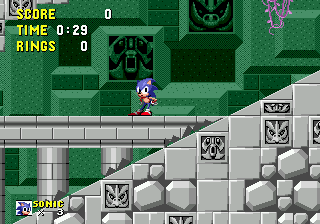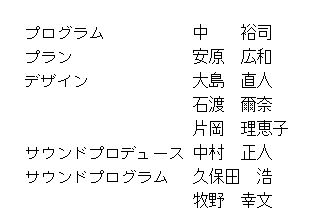Difference between revisions of "Sonic the Hedgehog (16-bit)/Hidden content"
From Sonic Retro
(Made the Kataoka link go to Kodama's page. She worked on the game, so it must be her. (http://www.theghz.com/forum/viewtopic.php?f=1&t=1893&st=0&sk=t&sd=a)) |
(I was able to find "Jina" as a legitimate nanori of those Kanji (using JWP), so I removed the parentheses) |
||
| Line 188: | Line 188: | ||
|Plan || [[Hirokazu Yasuhara|Yasuhara Hirokazu]] | |Plan || [[Hirokazu Yasuhara|Yasuhara Hirokazu]] | ||
|- | |- | ||
| − | |Design || [[Naoto Ohshima|Ooshima Naoto]] <br>[[Jina Ishiwatari|Ishiwatari | + | |Design || [[Naoto Ohshima|Ooshima Naoto]] <br>[[Jina Ishiwatari|Ishiwatari Jina]] <br>[[Rieko Kodama|Kataoka Rieko]] |
|- | |- | ||
|Sound Produce || [[Masato Nakamura|Nakamura Masato]] | |Sound Produce || [[Masato Nakamura|Nakamura Masato]] | ||
Revision as of 05:16, 4 May 2010
Contents
Unused Artwork
Special Stage Art
Note:All of these items can be seen in-game by using the debug mode to fall outside the playing area of the special stage. It is easier to see them when advancing frame-by-frame by pausing and pressing C.
| Artwork | Name | Description |
|---|---|---|
| "Zone" Icons | Found in the object list for the special stages, and its graphics found in the ROM, these unused special stage icons have no known use. They are labeled for Zones 1-6, suggesting that they may have warped Sonic to another Zone from within the special stage as a sort of shortcut. They are solid, like normal blocks. | |
| 1-up Icon | Extra life icon for the special stages. It is listed in the manual for the game, but it never actually appears in any of the special stages. It is, however, fully functional, and can be placed it in any special stage. The icon disappears like a ring when touched. | |
| "W" Icon | An icon with the letter W on it. Its use is unknown, and it has no function when placed in-game. This block is solid. |
Unused Monitors
| Artwork | Name | Description |
|---|---|---|
| Robotnik monitor | Does nothing. Is likely intended to hurt the player, as it does in Sonic the Hedgehog 2 (16-bit)'s 2-player mode. | |
| Goggles monitor | Does nothing. This is most likely accompanied by the unused goggle graphics. This may have provided the ability to breathe underwater. | |
| File:Statictv.png | Static monitor | Does nothing. This is found in various areas of Scrap Brain Zone the player can not normally access, such as inside walls. It is possible to break one of them, however, by "digging" into the wall in a jump and popping it (the image of the monitor being a portion of the "zappers"). |
| "S" monitor | Does nothing. This monitor also appears in Sonic CD prototype 510, where it grants the player both extra speed and invincibility. That is most likely the intended function of the monitor here, as a Computer & Video Games issue alludes to a powerup which grants extra speed and invincibility. This suggests that the S monitors were functional at that point in development. |
Unused Sonic Sprites
| Artwork | Description |
|---|---|
| This sprite shows Sonic standing while gasping for air. This was presumably used in Labyrinth Zone. | |
| This animation shows Sonic holding his breath while running. It is speculated that this was used during the countdown to signify no air is left for Sonic. | |
| This unused sliding sprite is similar to the one used in Sonic CD's Wacky Workbench Zone. | |
| As seen in a couple of prototype screenshots in magazines, Sonic appears to be striking a victory pose after passing the sign post. | |
| These Spin Dash-esque sprites are present in the final ROM, but their use is unknown. Some theories are that they were used for a move similar to the Spin Dash or that they are animations for some sort of warp movement, perhaps through winding tunnels. It's also possible that a teleporter like the one found in the 8-bit version of Scrap Brain Zone would have played the animation. | |
| This set of sprites showing Sonic falling or shrinking are not used in the game. While their intended use is unknown, they could have been used to simulate falling in the death animation. They may have also been used for a speed tunnel that would extend into the background. |
Zone-Specific Art
| Artwork | Zone | Description |
|---|---|---|
| Green Hill Zone | The checkered ball seen on the Green Hill Zone Boss appears to have been originally used in Green Hill Zone, as magazine pictures have shown Sonic riding down hills on it. | |
| File:Totem.png | Green Hill Zone | The two faces pictured here are not in their original palette, but these appear to be an earlier version of the faces on the totem poles of Green Hill Zone. |
| File:Missingghztiles1.gif | Green Hill Zone | These unused tiles were found in Green Hill Zone's tileset, and appear similar to the areas used in the underground areas of Sonic the Hedgehog (8-bit)'s GHZ. These may have also been used for a cut underground area. |

|
Marble Zone | These spikes are horizontal, rather than the vertical spikes used in the final Marble Zone. They are also slightly thinner. They are fully working by placing them, though. |
| Spring Yard Zone | This unused graphic can be found in the tileset for Spring Yard Zone. It is unused in the final game, and can be found in several prototype screenshots shown in magazine previews. | |
| Labyrinth Zone & Scrap Brain Zone | This is a horizontal sprite of the Burrobot. | |
| Star Light Zone | These lights were found in Star Light Zone's data but not used. | |
| Star Light Zone | The three machines shown were found in Star Light Zone's dataset, but not used in the final game. They appear to have been background objects rather than obstacles. | |

|
Final Zone | The left image shows the back of Robotniks legs which can't be seen normally. The right image is what is normally seen. |
| Ending | Bumper that appears to be a rosebud with an incorrect palette. The ending level shares its debug item list with the Special Stage, so the bumper is usable in both. |
Press Start Button
Many early previews of Sonic the Hedgehog showed the text 'Press Start Button' on the Title screen. In the final version it does not show up due to a in-game bug, but the graphics can be found inside the ROM. It is also possible to get them to display in the Japanese version. It appears after accessing the secret credits screen via a cheat code (in emulators, the region of the emulator must be set to Japan). An easier way to get it to appear is to enter the Game Genie code AB3A-DADV. You can also fix this bug in a disassembly, using this guide.
Splats the Bunny
Splats is a prototype badnik from Sonic the Hedgehog which was cut from the final game. Despite not appearing in the game, the badnik appeared in a set of promotional trading cards for the game, was shown on the box of a series of Japanese Sonic figures, and was featured in the UK Sonic the Comic. When Nemesis Format was finally cracked in 2002, the sprites were discovered in Sonic 1.Some controversy has broken out over the true coloring of Splats—though the sprites to the left have Sonic's palette applied to them and the trading card scan appears to have a bluish tint, the quality and validity of the card has been called into question. Other theories to his coloring include purple (for Spring Yard Zone's palette) and green (for Star Light Zone's second palette line.)
Goggles
The graphics were found hidden in the ROM. While the actual purpose of the goggles is unknown, it is speculated that they were meant to give Sonic the ability to breathe underwater.
Each frame of the graphic fits together with one of Sonic's poses. For example:
Floating Sonic Sprite
Though this floating sprite is used in a number of areas in Sonic 2, it is only used in Sonic 1 for a split second on the "Continue" screen. Notice the lack of a white stripe on his shoe.Unused Eggman Graphics
These graphics were found buried in the ROM. Their purpose is unknown, but it is speculated that they may be part of an "alternate ending sequence" in which Eggman explodes in the background while Sonic runs across the ending level in victory.
Unused Warping Effect
Thought to be the original method of accessing the special stage, this warp effect activates when Sonic touches the area in which the object is placed. Sonic disappears as he runs into it, and a warping noise plays. Sonic then reappears a few seconds later, likely as a method of testing the object.
Labyrinth Zone Act 4
When using the level/act select PAR code FFFE10:???? and selecting the third act of Scrap Brain Zone by changing the question marks to 0502 you are actually taken to Final Zone. To actually reach the Scrap Brain 3 used in the game you have to select the fourth act of Labyrinth Zone by changing the question marks to 0103. This means technically Scrap Brain Act 3 is another level of Labyrinth Zone.
True Level Order
The level order that is used during gameplay is actually quite different from the intended order according to the level slots. The level select in early revisions also arranges the levels in the intended order. Alternately, a simple level select Pro Action Replay code (FFFE10:??00) can be used to verify this:
| Level Name | Arrangement |
|---|---|
| Green Hill Zone | Green Hill Zone (00) |
| Marble Zone | Labyrinth Zone (01) |
| Spring Yard Zone | Marble Zone (02) |
| Labyrinth Zone | Star Light Zone (03) |
| Star Light Zone | Spring Yard Zone (04) |
| Scrap Brain Zone | Scrap Brain Zone (05) |
| Final Zone | Final Zone (05) |
Level slot 06 leads to the level used in the ending cutscene.
Commentary found in the Sonic Jam strategy guide also confirms that the Labyrinth Zone was originally intended to be the second zone but moved due to the difficulty of the level.
Hidden Japanese Credits
On the "Sonic Team Presents" screen are Japanese Credits, though they are hidden because of the palette. With a palette editor they can be shown.
The Credits translated:
| Position | Person |
|---|---|
| Program | Naka Yuuji |
| Plan | Yasuhara Hirokazu |
| Design | Ooshima Naoto Ishiwatari Jina Kataoka Rieko |
| Sound Produce | Nakamura Masato |
| Sound Program | Kubota Hiroshi Makino Yukifumi |
| Sonic the Hedgehog (16-bit) | |
|---|---|
|
Main page (Gen|2013|3D|Ages) Manuals Development |
show;hide
Scrapped Enemies: |

























